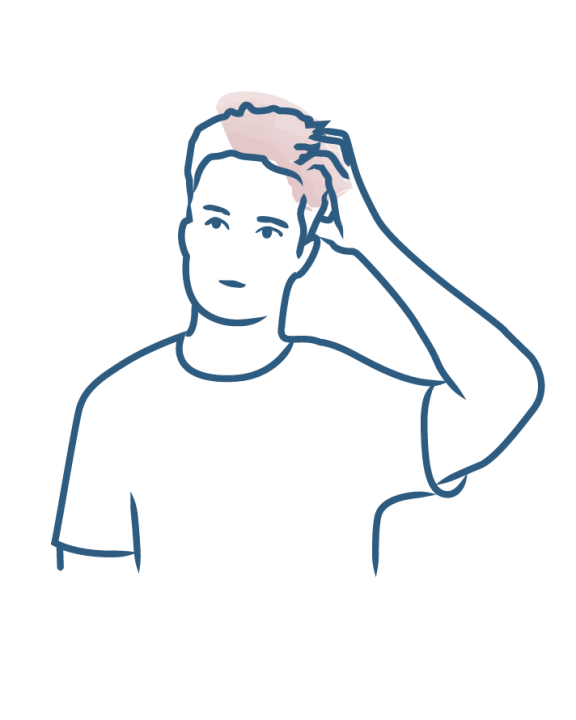Causes of itching: why do we scratch?
Pruritus sine materia

Pruritus sine materia
Pruritus is an unpleasant sensation that everyone knows. However, the causes of pruritus vary greatly from one person to another. Pruritus of non-dermatological origin, also called pruritus sine materia, is a broad category that includes systemic, neurological, psychogenic and all other prurits of undetermined cause. A better understanding of pruritus sine materia allows for a better understanding of the reasons for scratching and for improved treatment of affected individuals.
Recognizing pruritus sine materia
Pruritus sine materia is defined as pruritus of non-dermatological origin, i.e., pruritus without any skin lesions (such as spots or plaques) to explain it.
It can be accompanied by, sometimes very significant, skin lesions which appear due to scratching.
Pruritus sine materia can be localized or generalized and can affect absolutely any part of the body.
What are the causes of Pruritus sine materia?
The causes of pruritus sine materia are extremely varied. In order to clarify this, it is best to separate the different pruritus sine materia into several distinct categories, depending on the cause of pruritus.
Systemic pruritus
Many systemic diseases, more or less frequent, more or less serious, can be accompanied by pruritus sine materia. Among them are cholestasis, which is a liver condition; chronic kidney disease; blood diseases, especially lymphomas; cancers; autoimmune diseases; viral or parasitic infections; diabetes; thyroid disorders; certain micronutrient deficiencies, such as iron deficiency; etc. In some cases, it is the pruritus that is the most uncomfortable symptom for the person and is what pushes them to consult their doctor. Additional tests are then performed to establish a diagnosis and to set up a treatment adapted to the pathology in question. In the category of pruritus sine materia of systemic origin, it is possible to include all types of drug-induced pruritus and pruritus related to pregnancy.
Neurological pruritus
These prurits sine materia are due to an attack on the central nervous system (example: multiple sclerosis) or the peripheral nervous system (example: shingles). There are other types of neurological pruritus, such as those due to pinched nerves. Neurological pruritus is often accompanied by other troublesome symptoms such as tingling, burning or pain.
Psychogenic pruritus
Also called nervous pruritus, pruritus sine materia of psychogenic origin can be triggered by significant events such as a death, layoffs, the illness of a close relative, etc. Nervous itching is sometimes associated with a psychiatric illness, such as psychosis. In this case, pruritus can be the result of parasitic delirium and be particularly difficult to live with for the patient and those close to them. Psychogenic pruritus usually worsens during periods of rest, such as at night. Stress aggravates the itching associated with psychogenic pruritus.
Pruritus of undetermined origin
Here we find all the types of pruritus sine materia whose origins cannot be determined, after having eliminated all other possible causes. One of the most common pruritus sine materia present in this category is senile pruritus, which specifically affects the elderly.
In all cases, various factors tend to promote pruritus sine materia: skin dryness, climatic conditions, stress, the use of unsuitable hygiene and care products, clothing that is too tight, etc.
Relieving itching related to pruritus sine materia
The treatment of pruritus sine materia depends on the origin of the pruritus. There is no single treatment or miracle cure. Finding the cause of pruritus sine materia is essential for further management.
Whatever the cause of pruritus sine materia, simple measures can be taken on a daily basis to relieve the itching: taking quick warm showers, washing with a superfatted soap, a syndet or a cleansing oil, hydrating the skin with a moisturizer rich in anti-itching active ingredients, wearing loose cotton clothing, and relaxing in order to reduce pruritus caused by stress.
More information
- Discover Pruritus gravidarum or itching related to pregnancy
Causes of itching: why do we scratch?
Pruritus gravidarum or itching related to pregnancy
- Discover Aquagenic Pruritus
Causes of itching: why do we scratch?
Aquagenic Pruritus
- Discover Senile Pruritus
Causes of itching: why do we scratch?
Senile Pruritus
- Discover Sun Allergy
Causes of itching: why do we scratch?
Sun Allergy
- Discover Dermatological Pruritus
Causes of itching: why do we scratch?
Dermatological Pruritus
Our care routines
Itching on the scalp
Dermatological expertise
To better understand your skin and hair, discover our exclusive content and innovative care products designed to improve your quality of life..

